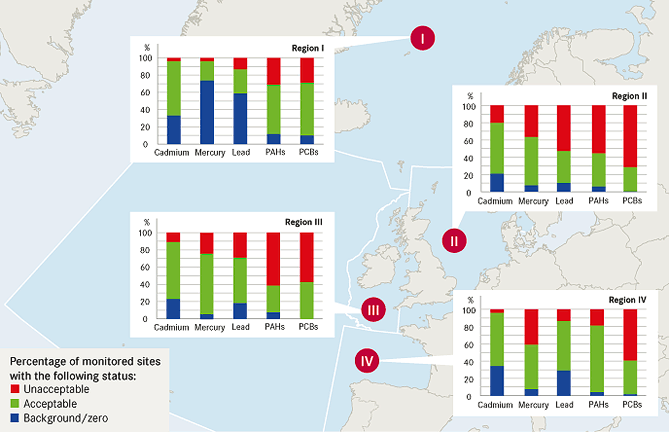Contamination of marine life with persistent hazardous substances (e.g. mercury, brominated flame retardants, PFOS, SCCPs) is widespread in all Regions. In Region I, contamination extends to the top level of the food chain in areas remote from most sources. This Region is particularly affected through long-range air transport and this gives rise to concern for the vulnerable Arctic ecosystem.
Additional effort is needed to achieve further progress
Moving closer towards the target of a cessation of discharges, emissions and losses of hazardous substances by 2020, requires OSPAR countries to fully implement existing measures, especially those required under the EU IPPC Directive, the EU Water Framework Directive and its Daughter Directive on priority substances, and the EU Marine Strategy Framework Directive. Abatement at source is still important and should be based on the precautionary principle and the principle of prevention. Best available techniques (BAT) and best environmental practices (BEP) must continue to be applied.
The OSPAR assessments show that priority chemicals can reach the North-East Atlantic through atmospheric transport and waste streams of imported products. The widespread presence of POPs in the OSPAR area emphasises the need for a global ban on the use of these chemicals. OSPAR should promote: the development of a legally binding global instrument on controls of emission sources of mercury within the framework of the United Nations Environment Programme (UNEP); and the inclusion of additional contaminants (e.g. SCCPs, HBCD and endosulfan) for phase-out under the Stockholm Convention on Persistent Organic Pollutants, and the Aarhus Protocol on Persistent Organic Pollutants to the UNECE Convention on Long-range Transboundary Air Pollution.
Achieving the cessation target will be difficult for many substances with sources for which control measures are difficult or impossible, for example, diffuse pollution from consumer products, historic pollution and releases from combustion processes.
OSPAR’s role at the European level
OSPAR has identified threats from a wide range of substances of possible concern for the marine environment which need to be tackled by the appropriate forum. OSPAR should focus on substances posing risks to the marine environment that are not yet adequately covered by the EU and by other international bodies. Continued cooperation with industry is important.
OSPAR should continue to make input to the EU on the identification, selection and prioritisation of hazardous substances which are of concern for the marine environment. OSPAR should also promote actions under the EU REACH Regulation and other relevant EU legislation to reduce releases of these substances from products and wastes, and control risks for the marine environment.
Monitoring and assessment to support the EU Marine Strategy Framework Directive
OSPAR should continue its key role in developing monitoring strategies to track progress on controlling hazardous substances. The OSPAR Coordinated Environmental Monitoring Programme (CEMP) has provided well-tested, quality-assured methodologies for environmental monitoring that can contribute to the evaluation of good environmental status under the EU Marine Strategy Framework Directive and good chemical status under the EU Water Framework Directive.
The CEMP should be further developed for future monitoring and assessment, supported by the following:
- Improved understanding of the effects of hazardous substances, particularly cumulative effects and endocrine disruption.
- Improved biological effects monitoring, integrated, where appropriate, with chemical monitoring.
- Extending datasets further offshore beyond the densely populated and industrialised coasts.
- Improved information collection on the production, uses and pathways to the marine environment, especially for substances which are not deemed suitable candidates for marine monitoring.
- Use of research results on concentrations and effects of hazardous substances on deep-sea species and ecosystems.
There is increasing evidence that climate change may alter pathways of hazardous substances to the North-East Atlantic and make marine ecosystems more vulnerable to chemical pollution. OSPAR should include considerations of climate change in future monitoring and assessment of hazardous substances.





